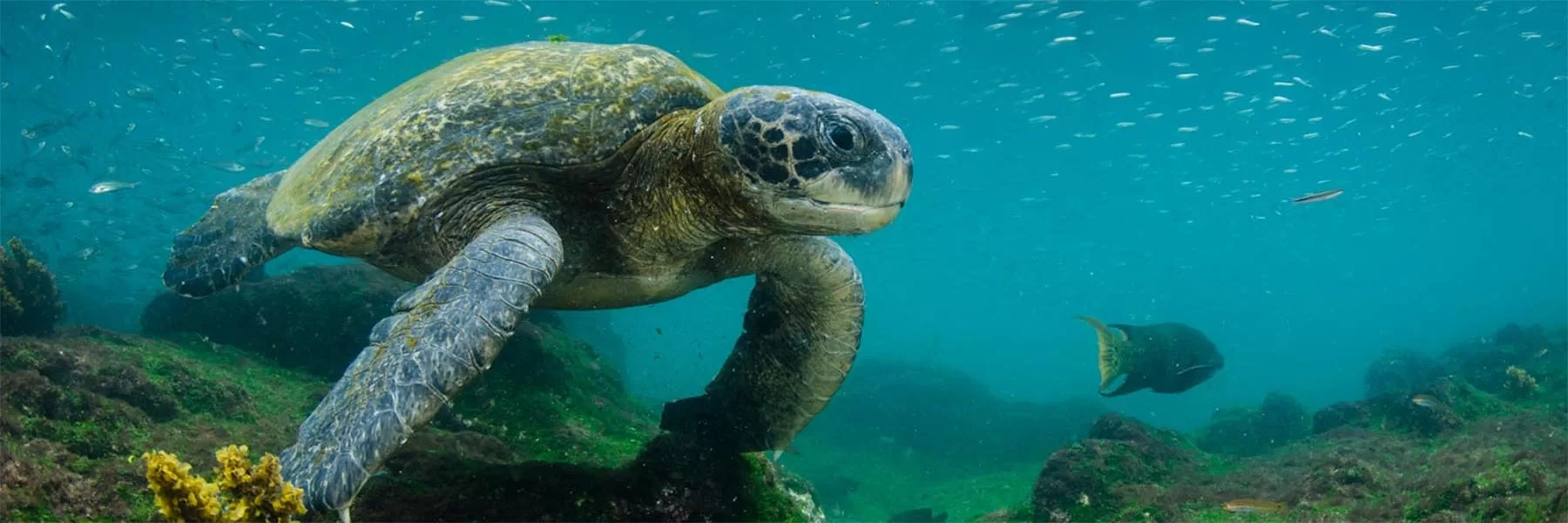The Galapagos Islands find themselves on every traveler’s bucket list for all the right reasons. This volcanic archipelago comprises 19 islands and many small islets situated 1,000 miles out into the Pacific.
These isolated islands in the Galapagos served as inspiration for the Theory of Evolution by Charles Darwin. The Galapagos Islands possess a truly spectacular and mesmerising quality that sets them apart from any other destination.

A cruise sails in the Rabida Island of Galapagos
The Galapagos Islands are a UNESCO world heritage site where you have the opportunity to explore their protected lands and waters. What makes the destination special is that the wildlife species on these islands cannot be found anywhere else in the world.
Furthermore, the unbeatable rich biodiversity, scenic landscapes, and interesting natural history make this isolated archipelago an exclusive destination to visit.
If this enchanting place on Earth intrigues you, take a look at our guide to the Galapagos Islands.
Climate and weather
Despite its equatorial position, the Galapagos Island has a subtropical climate. There are two seasons experienced in the islands: the warm wet season and the cold dry season.

The beautiful landscapes in Galapagos islands
The warm season occurs from January to June, when ocean and air temperatures are the warmest. During these months, cloudy conditions and occasional showers take place.
The cold, dry season occurs from July to December. During these months, the air and ocean temperatures cool down, while mist-like drizzle keeps the highlands and volcanoes of the Galapagos green.
When is the best time to visit?
The best time to go to the Galapagos Islands depends on what you want to experience and the weather you prefer.
- Peak season: From a tourism perspective, the busiest months tend to be June to August, as well as December and January.
- Wildlife: If you would like to experience flourishing wildlife, there are no fixed months to visit. Animals in Galapagos Islands have different breeding cycles throughout the year. Moreover, wildlife activities vary not only from month to month but also between islands. Yet, animals can be seen all year round as there are only a few migratory species.
- Snorkelling and swimming: From December to May, the Galapagos waters tend to be warm and shallow. You can swim with various marine animals, such as white-tipped reef sharks and sea turtles.
What Islands should I see in Galapagos?
There are 13 major islands in the Galapagos, including six other smaller islands. Out of the 13, only four islands are permanently inhabited by humans. The rest of the islands require visitors to travel with guides to designated places like marine and terrestrial sites only.
The Galapagos National Park was established to protect the unique animals, plants, and birds living on the archipelago. The park encompasses around 97 percent of the entire land area of the islands and 100 percent of the neighbouring marine habitat.
Here are the most popular islands in the Galapagos to visit:
Santa Cruz Island
This island is home to the largest human population in the Galapagos, but the majority of its land remains protected. Santa Cruz Island is also considered a good starting point for other islands. Here, you can see giant turtles in their natural habitats at El Chato. Moreover, you can learn about conservation projects at the Charles Darwin Research Station and enjoy beautiful beaches such as Tortuga Bay.

The panoramic views of the Santa Cruz island
Isabel Island
Isabel is the largest island in the Galapagos, where you can observe various species of penguins, giant tortoises, flamingoes, and sea lions. You can take a boat ride to a lava arch known as Los Tuneles, enjoy a day trip to Volcano Sierra Negra, and check out Centro de Crianza, a breeding centre for giant tortoises.

Darwin’s lake on Isabela Island
San Cristobal Island
On San Cristobal Island, the habited town of Puerto Baquerizo Moreno is steadily being developed as the main hub for tourism. The town is easily navigated on foot and is home to Kicker Rock, a prominent landmark rock formation known for snorkelling. San Cristobal is also the top spot for surfing.

The well-known Kicker rock landmark
North Seymour
North Seymour is a tiny island that is well-known for its arid vegetation. The popular blue-footed booby, a large population of Frigatebirds, and land iguanas thrive on this island. Snorkelling on North Seymour gives you a chance to see tropical fish, garden eels, rays, reef sharks, and more.

The hammerhead sharks of North Seymour
Floreana Island
Floreana is one of the oldest Galapagos islands. On its idyllic beaches, one can see endemic giant tortoises roaming around the coast. One of the most magnificent spots for snorkelling on the island is Devil’s Crown, a volcanic crater almost submerged in the ocean. Floreana is also famous for its Post Office Bay, which continues to operate even today!

The unusual Black Beach in Floreana Island
What animals are there in the Galapagos Islands?
Islands in the Galapagos are referred to as a living museum, where many animals are native only to the archipelago. Over thousands of years of evolution, these creatures have adapted to different weather conditions and landscapes.
Here are some iconic animal species found in the Galapagos:
1. Marine iguanas
Marine iguanas are the only marine lizards and have the largest colony in Fernandina. This iguana species lives on seaweed and dives up to 30 feet in the water. Marine iguanas are found on the rocky shorelines, mangrove beaches, and marshes of the Galapagos Islands.

Marine iguanas in Galapagos island
2. The frigatebird
The frigatebird is a huge seabird and an endemic species of the Galapagos Islands. The male frigatebird has the distinctive feature of a giant red-throat pouch under its beak. Frigatebirds can be seen all across the archipelago in deciduous trees and mangroves, as well as scavenging over coral reefs and the coast.

A male frigatebird
3. Galapagos penguins
Galapagos penguins are the only penguin species living north of the equator. This species can survive due to the unique biogeography of the Galapagos Islands. They are frequently spotted on the west coast of the Isabela and Fernandina Islands.

A colony of Galapagos penguins
4. Galapagos giant tortoises
Galapagos giant tortoises are the world’s largest tortoises, growing up to 230 kg (500 lbs.) and living for more than 100 years. Although these species are found on several islands, they exist in greater numbers on Isabel Island.

A Galapagos giant tortoise in a national park
5. Blue-footed booby
These bird species come to the Galapagos Islands to nest along the rocky coasts. Their large blue feet are unique features that are very popular among visitors, along with an entertaining dance they perform during the mating season.

A blue-footed booby
Is cruise better or land tour?
Galapagos cruises
One of the most enjoyable ways to travel around the Galapagos Islands is on a multi-day cruise. These cruises generally cover a great range of islands and provide an activity-packed itinerary all set for you. Vessels also travel to islands at night so that you can wake up to a new destination every day, increasing your chances of seeing diversified wildlife.
Several of the terrestrial and marine sites in the Galapagos are extremely isolated and are only accessible by boat. Moreover, some cruises are already equipped with snorkel gear, kayaks, and paddleboats for expedition activities.
Land tours
Compared to cruises, land tours are less expensive and offer more flexibility. It is also the most sought-after for those susceptible to seasickness. After wildlife viewing and nature excursions, travellers have the freedom to unwind or explore other towns without any restrictions.
When you opt for land tours, you can plan your entire itinerary, including day trips to national parks on selected islands. Additionally, you can customise your schedule to stay overnight on islands such as Santa Cruz, San Cristobal, and Isabel.
How to get to Galapagos Islands?
Mainland Ecuador is the most popular option to get to Galapagos Island. You need to travel to the capital city of Quito or Guayaquil, where the islands are much closer There are two airports in the Galapagos: Seymour Airport and Airport Isla San Cristobal.
Additional tips for travel to Galapagos Island
- It is recommended to book your Galapagos trip at least a year in advance, as cruises usually sell out soon, especially in the peak seasons.
- Although medical care in Galapagos Islands is improving, the destination is still remote. Carry all your prescriptions, including those prone to seasickness.
National Park rules
- To enter Galapagos National Park, you need to pay a mandatory fee of $100 for adults and $50 for children less than 12 years old.
- Stay at least 2 metres away from plants and animals.
- Touching, feeding, and petting animals are not allowed.
- Camping is only allowed in designated areas of the park.
- You cannot visit uninhabited islands unless and until you travel with a naturalist guide.
- Do not take any organic materials like shells, rocks, or plants when you leave the island.
What to pack
- Bring along comfortable and lightweight clothes for outdoor excursions in Galapagos. Long sleeves and pants offer protection against the sun, while a light sweater and jacket are perfect for cooler evenings.
- Wear hiking or mesh water shoes.
- Other essential items to bring along include a waterproof backpack, reusable water bottle, insect repellent, sunblock, hat, camera, and binoculars.
Visiting Galapagos Island is a unique experience that unravels the hidden natural wonders of the archipelago. If you are keen to visit the islands of the Galapagos, feel free to refer to this guide.
If you loved reading this story, then subscribe to our blog here (it will ask to verify your email) to get inspiring travel stories and trivia delivered to your email. Stories about wildlife trivia, cultural experiences, curated luxury hotel lists, underrated places to travel, polar journeys and much more.











